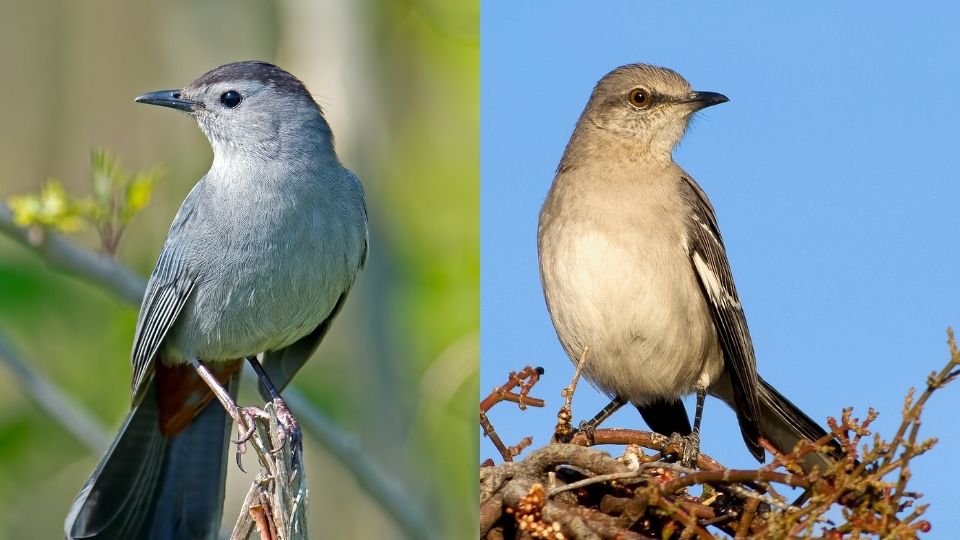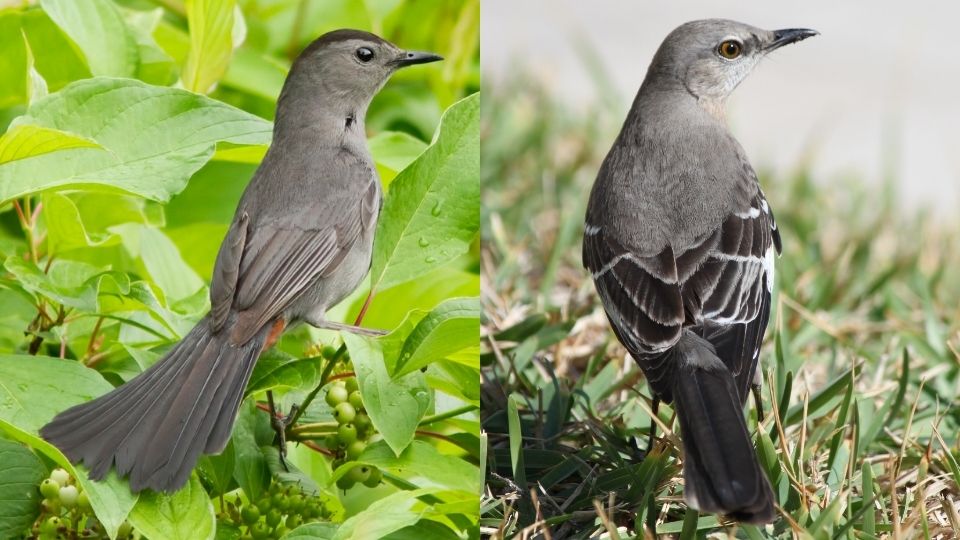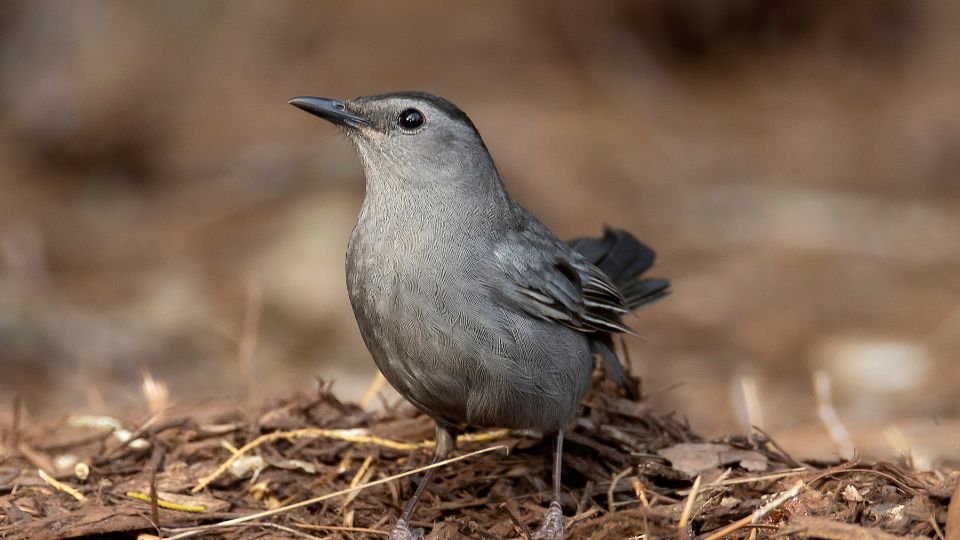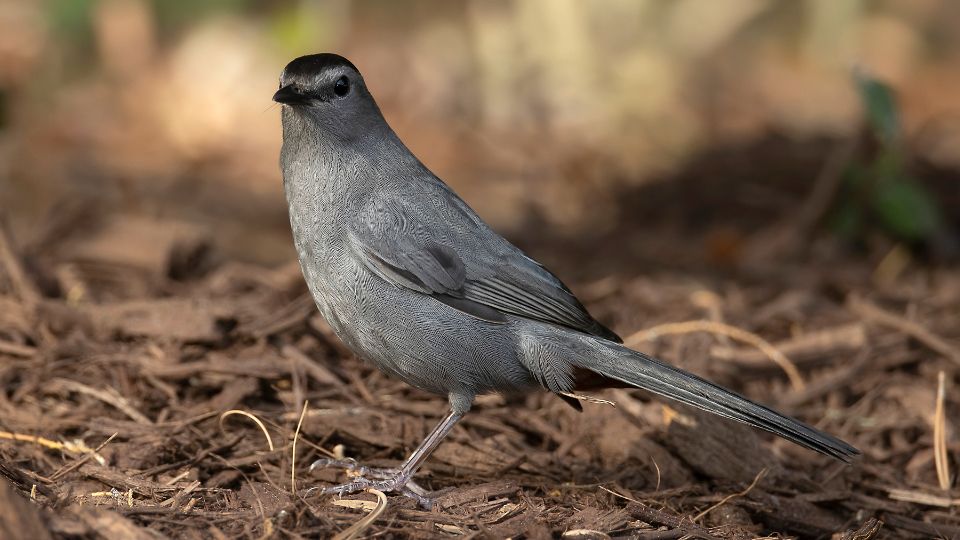Catbirds and mockingbirds are both mimidaes, but mockingbirds are larger and have pale accents along their underparts. Overall, the mockingbird is a bigger bird with lighter coloring and has a more expansive habitat when compared to the catbird. They’re both gray birds, but the catbird is darker in color than the mockingbird.
Mockingbirds live in almost all 50 states, from the west coast to the east coast, while catbirds are predominately found in the eastern United States. Mockingbirds live in almost all 50 states, with higher concentrations in warmer climates near Florida and Texas.
You can spot them on both coastlines as well. On the other hand, the catbird is primarily found in the eastern section of the United States (and down into the Caribbean), and they are not located on the western shoreline past the Rocky Mountains.
Even for experienced bird watches, spotting the difference between the Northern Mockingbird and Gray Catbird is challenging. While these two mimidaes share a lot in common, very subtle differences in their size, songs, coloring, and even habitat make it easy to spot the difference between these unique Passeriformes quickly!
While these Passeriformes are related, their coloring, habitat, and mimicked songs are slightly different.
Let’s dive into the differences between the Dumetella carolinensis (Gray Catbird) and the Mimus polyglottos (Northern Mockingbird).
Difference in Size
Overall, Mockingbirds are slightly larger than the gray catbirds. It is tricky to tell them apart from size alone, but observing their tail feathers will also help in differentiating both species.
Mockingbirds: The mockingbird measures 8.1 to 11 inches with long and distinguishable tail feathers. At a glance, the tail feathers of the mockingbird look almost as long as its entire body. Overall, the size of a mockingbird is similar to a Starling or an American Robin.
Catbirds: Technically, the catbird is smaller than a mockingbird, but not by much. They typically measure between 8.3 inches to 9.4 inches. They also have long tail feathers that look almost as long as their entire body. Catbirds look very similar to a starling’s size, with noticeable coloring differences.

Differences in Coloring
One of the easiest ways to spot the difference between these two very similar birds is to take notice of the coloring and pattern of feathers. Catbirds have a solid color with minor detail, while mockingbirds have various contrasting colors and patterns, especially on the tail feathers.
Mockingbird: The most noticeable detail of the northern mockingbird is that it has a gray coloring with a white underbelly. These white accents are prominent in the belly and have white patches near the head. The eyes of the mockingbird are black and often rimmed with white accents.
Another noticeable feature of the mockingbird is that it also has more detail in the pattern of the tail feathers. Mockingbirds have dark gray tail feathers lined with white, making them much easier to spot.
Catbird: The gray catbird, on the other hand, is primarily gray with very few distinguishing features. It has muted gray feathers that span from the top of its head to the base of its tail feathers. However, two very distinct features make it stand out from mockingbirds.
Gray catbirds often have a black cap right on the tip of their heads, which is something that mockingbirds don’t have. They also have a few faint dusting of rust-orange feathers right at the base of their tails.

Different Songs
In the great North America sing-off, the Mockingbird wins by a mile. While both birds are avid Mimidae (along with Thrashers), the mockingbird is more skilled at mimicking songs of other birds than the gray catbird.
Mockingbird: The mockingbird often imitates other songbirds to attract a mate. Overall, Mockingbirds are capable of mimicking over 200 songs that range from songbirds to car alarms. Their parodied songs often last up to two minutes and can be heard well into the night.
Catbird: The gray catbird can only mimic 100 songs that can be anything from a creaky gate to other songbirds. What makes the catbird song special, however, is that it can last up to 10 minutes! Their 10-minute songs often include the songs of various birds and change wildly in tempo.
The gray catbird also has a song that sounds very similar to the mewing of a kitten. This song is unique to the Gray Catbird (hence the name!) and makes it easier to spot among backyard bird watchers.

Differences in Diet
Knowing what they love to eat is vital if you want to attract these birds to your backyard. Overall, the diet of the Mockingbird and Grey Catbird is very similar.
Mockingbird: Mockingbirds live on a diet of primary insects during the summertime. They feed on mealworms, grasshoppers, caterpillars, crickets, beetles, and other bugs. Nestlings are also only fed a diet of insects alone.
In the late summer and winter months, mockingbirds switch up their diet to things like berries and suet. If you want to attract a Mockingbird to your bird feeders, try mealworm suet cakes.
Catbird: The Gray Catbird has a very similar diet to Mockingbirds. In the summer months, Gray Catbirds live on a diet of primary bugs, especially early in the summer. As food becomes scarce, they eat things like blackberries and raspberries and occasionally partake in a backyard feeder’s offerings.
In the video below, we rounded up 10 of the most fascinating facts about mockingbirds!
Different Habitat
Mockingbirds and Gray Catbirds are found all over North America and in parts of Canada and Mexico. However, you can sometimes spot the difference between these two species of North American birds based on location alone.
Mockingbird: While the Mockingbird resides in all portions of North America, they are more predominant in the southern United States. They are the state bird of five southern states, including Texas, Florida, Tennessee, and Mississippi.
They live in places like thickets, dense deciduous forests (especially in New York), grasslands, savannas, and the edges of deserts. They also reside in urban areas with plenty of spaces to build a nest and fewer predators.
Catbird: While gray catbirds live in North America, they aren’t found in every state. During the breeding season, they live in the midwest and eastern portion of the United States and Canada and aren’t located past the Rocky Mountains.
In non-breeding months, Gray catbird will migrate south to Florida and Mexico, making their classic mewing sounds to locate each other as they travel. Gray catbirds also flock in groups of approximately 10 to 15.

Catbird vs Mockingbird: Quickly Spot the Difference
Observing the patterns and colors on the feathers is the easiest way to spot the difference. Mockingbirds have two white wing bars, which catbirds do not have. Mockingbirds are also larger in size and have a lighter underbelly.
These two bird species have much in common; even the most seasoned birdwatcher may struggle to tell them apart. If you live in an overlapping area of North America that hosts both mockingbirds and gray Catbirds, spotting the coloring is the quickest way to tell these two birds apart.
It’s also near-impossible to distinguish these two songbirds from song alone since both are avid mimics. However, if you notice that a song that goes on for around 10 minutes changes tempo and mashes up different songbird songs, odds are it’s a gray catbird!

